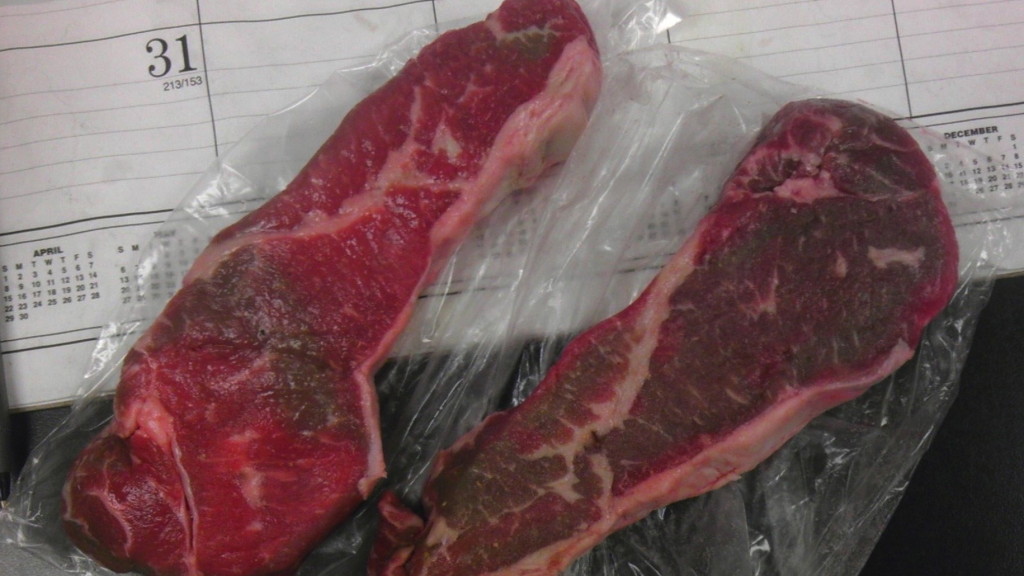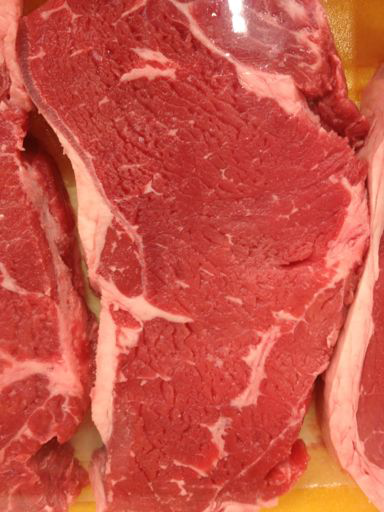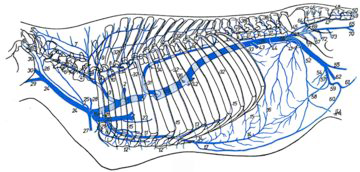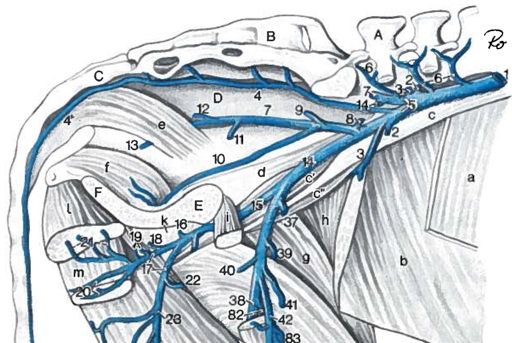We received a request to answer the question why there was a line of fat sometimes present in beef strip steaks. A customer of a meat purveyor had requested a credit for this “defect,” and this is the photo that was sent to us to help answer why this line of fat was present. Gatlan Gray, then graduate teaching/research assistant in our program, prepared this response to this question.
The line of fat that is sometimes seen in a few New York strip steaks or beef top loin steaks (M. longissimus lumborum) from a beef strip loin is a normal occurrence. Often times, this line of fat is overlooked and accepted as seam fat. However, this is not exactly the case. It is in fact a line of fat, but it is also part of the circulatory system. Muscles need the supply of the circulatory system, and to make that possible, the epimysium (the connective tissue that surrounds the muscle) allows for blood vessels to enter into and exit the muscle, transporting blood, oxygen, and nutrients. Blood vessels vary in size and functionality, from large arteries and veins that carry blood from the heart or to the heart, to very small arteries, veins, or capillaries contained within muscles.
The routing of blood vessels lies in the channels between the sheets of perimysium that surround muscle bundles. As blood vessels are routed within the muscles of an animal, there is an accumulation of fat that surrounds larger blood vessels to even the smallest of blood vessels, which is what is being seen in the case of some strip steaks.
The line of fat that is sometimes visible on the cut surface of strip loin steaks is the lumbalis vein and artery. Lumbales veins and arteries are paired vessels that originate from a larger vessel, the caudal vena cava (Figure 1) and the abdominal aorta (Figure 2), respectively. The lumbales veins and arteries will be present in both sides of the animal, and correspond to the number of lumbar vertebrae in each particular mammal species (Beef animals will have approximately 6 pairs of lumbales veins and arteries).
From the vena cava and aorta artery, the lumbalis vessels curve to the caudal (rear, from the direction of the head) border of the transverse process and branches toward the body of the vertebra, or spinal column (Figure 3 and 4). One of the arterial branches supplies the spinal canal and cord, while the other arterial branch supplies branches of blood vessels for the loin muscle. The veins will deliver the blood back to the heart.
Although the line of fat that surrounds the blood vessels is not visible on the cut surface of all strip loin steaks, it does not mean that it is not present. In fact, because these branched blood vessels supply the inner portions of the muscle, they are intertwined within the network of the muscle. Additionally, because the exact paths of the blood vessels in the muscle do not necessarily follow the same path, the visible amount of fat present at the cut surface will not be the same on each steak. The presence of the line of fat at the cut surface could be altered by slightly changing the thickness of the steak. The angle at which the steak is portioned in relation to the direction of the blood vessel, making the line of fat more or less visible depending on whether the angle at which the steak is cut against the blood vessel or parallel to the length of the blood vessel. The presence of these circulatory vessels is a fascinating and inherent characteristic of all meat products, and interestingly just so happens to be more noticeable in some muscles rather than in others.
Note: Gatlan Gray received his M.S. degree in Animal Science in 2012 and now works for Walmart Foods, Inc., Bentonville, Arkansas.





